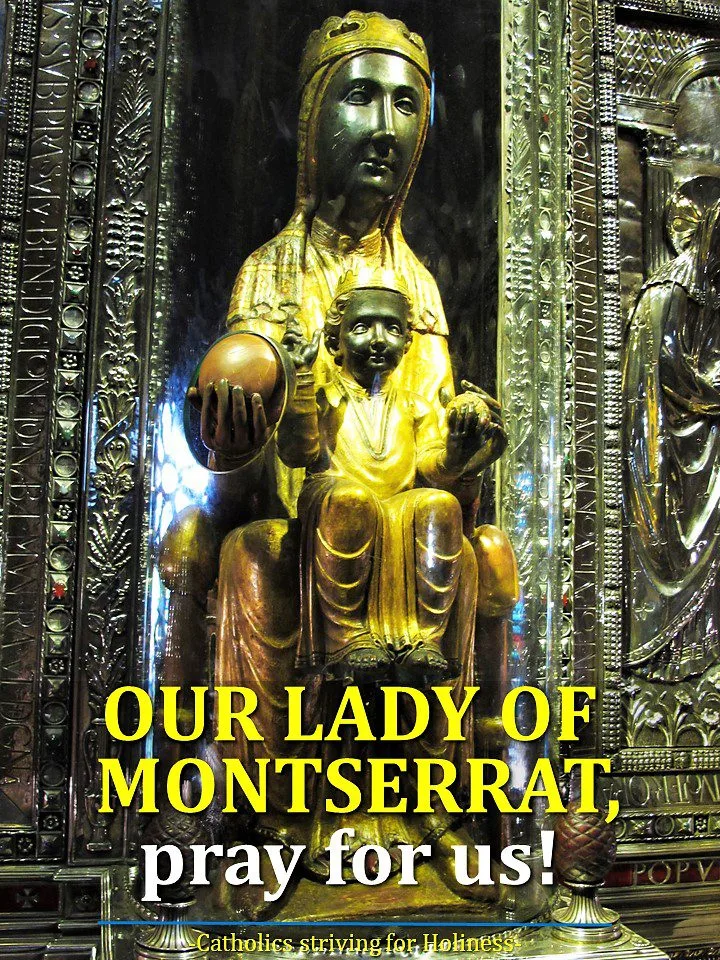April 27: OUR LADY OF MONTSERRAT

Our Lady is venerated under the invocation of the Virgin of Montserrat or “Rosa d’abril” – because of the Virolai hymn sung to her – at the Santa Maria de Montserrat monastery in the Montserrat mountain in Catalonia, Spain.
It is one of the black Madonnas of Europe, hence its familiar Catalan name, la Moreneta (“The little dark-skinned one”).
Legend tells that in the year 880, on a Saturday night when the sun was going down over Montserrat, some boy shepherds saw a bright light coming down from the sky, accompanied by beautiful music. The following Saturday they returned with their parents. And the vision came to them again. On the following four Saturdays, the Rector of Olesa went with them. And everyone saw the vision.
The image of Our Lady of Montserrat, popularly known as La Moreneta (the Dark One), due to the dark colour of Her skin, is a truly beautiful 12th-century Romanesque polychrome carving. Pope Leo XIII proclaimed Our Lady of Montserrat Patron Saint of Catalonia in 1881. In 1947, the image was enthroned in a silver altarpiece, paid for by popular subscription and installed in the upper section of the basilica apse.
The figure of Our Lady stretches out Her right hand, which holds the globe, symbolising the cosmos. Our Lady nearly rests Her left hand on the Child’s shoulder, indicating that this omnipotent king is Her Son. With His right hand, the Child gives a blessing, whilst His left hand holds a pinecone, symbol of fertility and everlasting life.
AUDIO SOURCE: PERSONAL RECORDING OF “Virolai” sung during the visit by the Basilica choir.
TEXT SOURCE: http://www.abadiamontserrat.cat
PHOTO SOURCES: VIDEOS ARE PERSONAL PROPERTY. OTHER PHOTOS FROM:
https://commons.wikimedia.org/…/File:MontserratMonastery01.…
De Misburg3014 – Trabajo propio, CC BY-SA 3.0, https://commons.wikimedia.org/w/index.php?curid=22225943
Saint Josemaria and Our Lady of Montserrat: The miraculous healing of St. Josemaria from severe Diabetes Mellitus (April 27, 1954).
On April 27, 1954, something like this happened to Monsignor Escrivá. It was the feast of Our Lady of Montserrat. Don Alvaro had, as usual, given him an injection five or ten minutes before lunch, but at a lower dosage than that prescribed and using a new kind of long-acting insulin. They went down to the dining room. Shortly after saying grace, as they sat facing each other, the Father suddenly said, “Alvaro! Absolution!” Don Alvaro tells what happened next:
I didn’t understand him. I just could not understand him. God permitted that I did not understand him. And then he repeated, “Absolution!” And for a third time—this was a matter of a few seconds, in all— “Absolution: ‘Ego te absolvo …’” And at that moment he lost consciousness. I recall that first he turned a kind of purplish red and then an ashen yellow. And his body seemed to have become very small.
I gave him absolution immediately and did what I could. I called the doctor and put sugar in his mouth, forcing him, with water, to swallow it, because he was not reacting and I could not feel any pulse.
When the doctor — Miguel Angel Madurga, a member of Opus Dei — arrived, the Father had already regained consciousness. The shock had lasted ten minutes. Miguel Angel carefully examined him and confirmed that he was out of danger and there were no complications. The Father, in fact, seemed to have gotten well.
Indeed, he immediately started worrying about that son of his, Miguel Angel. Learning that he had not yet had lunch, he had him eat something, chatting with him all the while and giving no hint that he could not see.
“My son,” he said to Don Alvaro when the doctor had left, “it’s left me blind. I can’t see a thing.”
“Father, why didn’t you tell the doctor?”
“Because I didn’t want to worry him unnecessarily. This may just go away.”
He was blind for several hours. Then, gradually, his sight returned. When he could finally see himself in a mirror, he said, “Alvaro, my son, now I know how I’ll look when I’m dead.”

“You look as fresh as a daisy, Father,” Don Alvaro answered. “You should have seen yourself a few hours ago—you really did look like a corpse.”
Not only had he looked like a corpse, but he had seen his whole life pass by very quickly, as if in a movie. The founder, says Don Alvaro, told him that in that moment in which he saw his life pass before him, “he had had time to ask God’s forgiveness for all the things he felt were faults of his, including even some failures in understanding. For example, the founder thought the Lord had once given him to understand that he would die much later. And he begged pardon for this too—for not having understood him.”
He had been suffering from diabetes for about ten years. Now the metabolic disorders characteristic of diabetes speedily disappeared. His insulin treatment was discontinued.
Dr. Faelli, the specialist who treated him, situated the key moment of the cure precisely in the occurrence just described. “He was cured of diabetes,” the doctor stated, “after an allergic attack in the form of a skin eruption and a sudden loss of consciousness.” He emerged from the anaphylactic shock “cured of the diabetes and its complications; he never had any relapse; and he was no longer under any dietary restriction. It was a case of a scientifically inexplicable cure.” (from Andres Vazquez de Prada, The Founder of Opus Dei, vol. III, pp. 172-173.)
READ MORE in HERE
Stay updated: subscribe by email for free TO OUR NEW WEBSITE www.catholicsstrivingforholiness.org (PUT YOUR EMAIL IN THE SUBSCRIBE WIDGET).
We are also in www.fb.com/Catholicsstrivingforholiness. Kindly help more people in their Christian life by liking our page and inviting your family, friends and relatives to do so as well. Thanks in advance and God bless you and your loved ones! Fr. Rolly Arjonillo